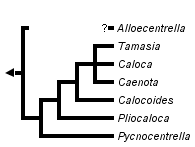Calocidae
Karl Kjer


This tree diagram shows the relationships between several groups of organisms.
The root of the current tree connects the organisms featured in this tree to their containing group and the rest of the Tree of Life. The basal branching point in the tree represents the ancestor of the other groups in the tree. This ancestor diversified over time into several descendent subgroups, which are represented as internal nodes and terminal taxa to the right.

You can click on the root to travel down the Tree of Life all the way to the root of all Life, and you can click on the names of descendent subgroups to travel up the Tree of Life all the way to individual species.
For more information on ToL tree formatting, please see Interpreting the Tree or Classification. To learn more about phylogenetic trees, please visit our Phylogenetic Biology pages.
close boxIntroduction
This family is endemic to Australia and New Zealand, established by Ross (1967) to accommodate genera originally placed in Sericostomatidae, Beraeidae, or Odontoceridae. As with other new families established in this paper, Ross gave no family diagnosis or indication of included genera. In the same paper, he placed Pycnocentrella eruensis Mosely, originally described in Beraeidae, in his newly created family Pycnocentrellidae, later synonymized with Calocidae by Neboiss (1977). The New Zealand genus Alloecentrella Wise, first described in Beraeidae and at times included in the Helicophidae was formally transferred from Calocidae to Helicophidae by Henderson and Ward (2007); their phylogenetic analysis revealed its close affinity to other helicophid genera. In its present composition, the family now contains 6 genera endemic to Australia (Caenota Mosely, Caloca Mosely, Calocoides Neboiss, Pliocaloca Neboiss, Tamasia Mosely) and 1 endemic to New Zealand (Pycnocentrella), with a total of 19 species.Characteristics
One Tasmanian species is terrestrial and lives under moss and leaf litter in wet sclerophyll forest, but others occur in small, woodland streams among plant roots and accumulations of detritus (Jackson 1998, Neboiss 1979). They construct slightly curved and tapered cylindrical cases of small rock fragments or somewhat flattened cases of 2 dorsal and 2 ventral rows of leaf material (Jackson 1998). Adults are small to rather large (forewing lengths 5-14 mm) and have dark forewings patterned with irregular white spots. In males of some genera, the antennal scape has expandable lobes and the head bears long, expandable filaments (Neboiss 1986). Taken from Holzenthal et al., 2007.Discussion of Phylogenetic Relationships
Combined analyses of Kjer et al. (2002), and Holzenthal et al., (2007b) did not place any confidence with the position of Calocidae within the Sericostomatoidea. The monophyly, as well as the relationships among the genera were examined by Johanson and Malm (2010).References
Henderson, I.M. & Ward, J.B. (2007) Three new species in the endemic New Zealand genus Alloecentrella (Trichoptera), and a re-evaluation of its family placement. Aquatic Insects, 29, 79–96.
Holzenthal R.W., Blahnik, R.J., Prather, A.L., and Kjer K.M. 2007a. Order Trichoptera Kirby 1813 (Insecta), Caddisflies. In: Zhang, Z.-Q., and Shear, W.A. (Eds). 2007 Linneaus Tercentenary: Progress in Invertebrate Taxonomy. Zootaxa. 58 pp. 1668:639-698
Holzenthal R.W., Blahnik, R.J., Kjer K.M and Prather, A.L. 2007b. An update on the phylogeny of Caddisflies (Trichoptera). Proceedings of the XIIth International Symposium on Trichoptera. Bueno-Soria, R. Barba-Alvearz and B. Armitage (Eds). pp. 143-153. The Caddis Press.
Jackson, J.E. (1998) Preliminary guide to the identification of late instar larvae of Australian Calocidae, Helicophidae and Conoesucidae (Insecta: Trichoptera). Co-operative Research Centre for Freshwater Ecology Identification Guide, 16, 1–81.
Johanson, K.A., and T. Malm. 2010. Testing the monophyly of Calocidae (Insecta: Trichoptera) based on multiple molecular data. Mol. Phylogenet. and Evol. 54:535-541.
Neboiss, A. (1977) A taxonomic and zoogeographic study of Tasmanian caddis flies (Insecta: Trichoptera). Memoirs of the National Museum of Victoria, 38, 1–208, plates 1–3.
Neboiss, A. (1979) A terrestrial caddis-fly larva from Tasmania (Calocidae: Trichoptera). Australian Entomological Magazine, 5, 90–93.
Neboiss, A. (1986) Atlas of Trichoptera of the SW Pacific-Australian Region. Series Entomologica, 37, Dr W. Junk, Dordrecht.
Ross, H.H. (1967) The evolution and past dispersal of the Trichoptera. Annual Review of Entomology, 12, 169–206.
About This Page
Karl Kjer

Rutgers University, New Brunswick, New Jersey, USA
Correspondence regarding this page should be directed to Karl Kjer at
Page copyright © 2010 Karl Kjer
 Page: Tree of Life
Calocidae.
Authored by
Karl Kjer.
The TEXT of this page is licensed under the
Creative Commons Attribution-NonCommercial License - Version 3.0. Note that images and other media
featured on this page are each governed by their own license, and they may or may not be available
for reuse. Click on an image or a media link to access the media data window, which provides the
relevant licensing information. For the general terms and conditions of ToL material reuse and
redistribution, please see the Tree of Life Copyright
Policies.
Page: Tree of Life
Calocidae.
Authored by
Karl Kjer.
The TEXT of this page is licensed under the
Creative Commons Attribution-NonCommercial License - Version 3.0. Note that images and other media
featured on this page are each governed by their own license, and they may or may not be available
for reuse. Click on an image or a media link to access the media data window, which provides the
relevant licensing information. For the general terms and conditions of ToL material reuse and
redistribution, please see the Tree of Life Copyright
Policies.
- First online 17 July 2010
- Content changed 20 July 2010
Citing this page:
Kjer, Karl. 2010. Calocidae. Version 20 July 2010 (under construction). http://tolweb.org/Calocidae/14631/2010.07.20 in The Tree of Life Web Project, http://tolweb.org/





 Go to quick links
Go to quick search
Go to navigation for this section of the ToL site
Go to detailed links for the ToL site
Go to quick links
Go to quick search
Go to navigation for this section of the ToL site
Go to detailed links for the ToL site